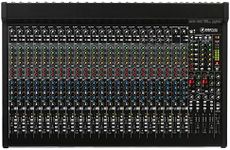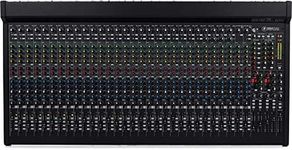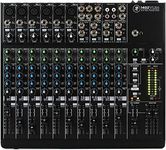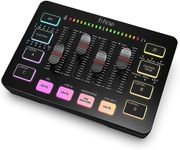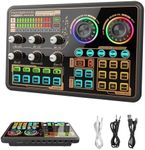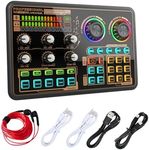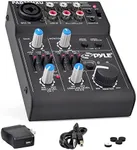Buying Guide for the Best Mackie Mixers
When choosing a Mackie mixer, it's important to consider your specific needs and how you plan to use the mixer. Whether you're a musician, a podcaster, or a live sound engineer, the right mixer can make a significant difference in the quality of your audio. Understanding the key specifications will help you make an informed decision and ensure that you get the best mixer for your requirements.Number of ChannelsThe number of channels on a mixer determines how many audio sources you can connect and control simultaneously. This is important because it dictates the mixer's capacity to handle multiple inputs like microphones, instruments, and other audio devices. Mixers typically range from a few channels (4-8) for small setups to many channels (16-32 or more) for larger, more complex setups. If you're a solo performer or podcaster, a mixer with fewer channels may suffice. However, if you're managing a band or a larger production, you'll need a mixer with more channels to accommodate all your inputs.
Input TypesMixers come with different types of inputs, such as XLR, 1/4-inch, and RCA. XLR inputs are commonly used for microphones and provide balanced connections, which reduce noise and interference. 1/4-inch inputs are versatile and can be used for instruments and line-level devices. RCA inputs are typically used for consumer audio equipment. It's important to choose a mixer that has the right combination of input types for your equipment. For example, if you primarily use microphones, ensure the mixer has enough XLR inputs.
EQ (Equalization) ControlsEQ controls allow you to adjust the frequency response of each channel, which can help you shape the sound to your liking. This is important for achieving a balanced mix and ensuring that each audio source sounds its best. Mixers may have simple EQ controls (like bass and treble) or more advanced options (like parametric EQs with multiple bands). If you need precise control over your sound, look for a mixer with more advanced EQ options. For basic applications, simpler EQ controls may be sufficient.
Built-in EffectsSome mixers come with built-in effects like reverb, delay, and compression. These effects can enhance your audio and add a professional touch to your mix. Built-in effects are particularly useful for live performances and recording, as they save you from needing additional external equipment. If you plan to use effects regularly, look for a mixer with a good selection of built-in effects. If effects are not a priority for you, this feature may not be as important.
Auxiliary SendsAuxiliary sends (or aux sends) allow you to create separate mixes for different purposes, such as monitor mixes for performers or effects sends. This is important for live sound situations where performers need to hear themselves differently from the main audience mix. Mixers can have multiple aux sends, and the number you need depends on your setup. If you're working with multiple performers or need to send audio to external effects processors, look for a mixer with more aux sends. For simpler setups, fewer aux sends may be adequate.
USB/Recording CapabilitiesMany modern mixers come with USB connectivity, allowing you to connect the mixer to a computer for recording and playback. This is important for recording sessions, live streaming, and integrating with digital audio workstations (DAWs). If you plan to record your mixes or use the mixer in a digital setup, look for a mixer with USB capabilities. Ensure it supports the necessary sample rates and bit depths for your recording needs. If you don't need to record or use a computer, this feature may not be essential.
Size and PortabilityThe physical size and portability of a mixer can be important, especially if you need to transport it frequently. Larger mixers offer more features and channels but can be bulky and heavy. Smaller mixers are more portable but may have fewer features. Consider how and where you'll be using the mixer. If you need to move it often or have limited space, a more compact mixer may be better. For permanent installations or larger setups, a bigger mixer with more features might be the right choice.



